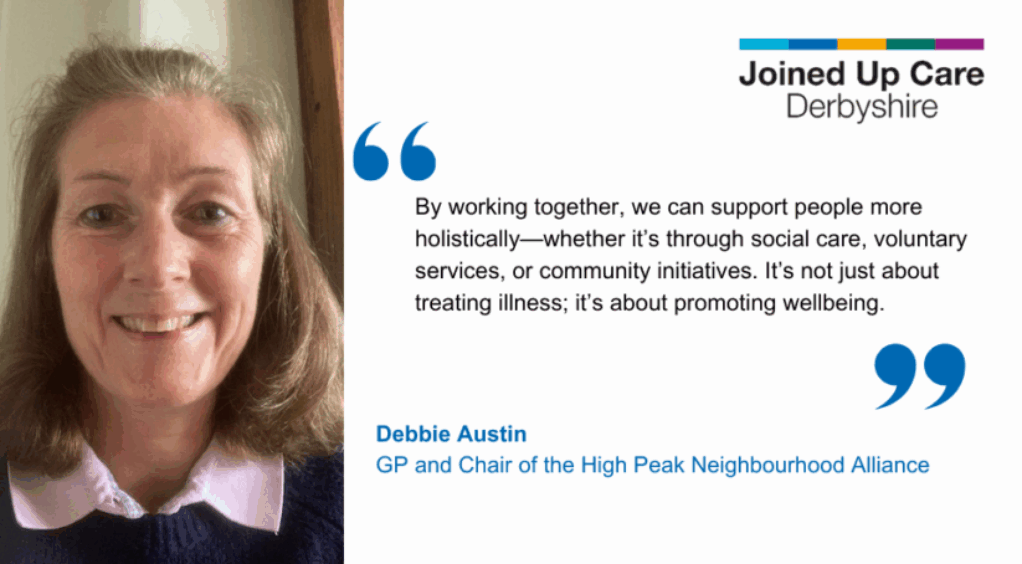Leading Differently in Neighbourhoods: Leadership creates platforms where change-makers can connect and collaborate
Leading Differently in Neighbourhoods
This series explores leadership, values and impact within the neighbourhood model in Derby and Derbyshire.
Leadership creates platforms where change-makers can connect and collaborate
Interview with Debbie Austin, GP and Chair of the High Peak Neighbourhood Alliance
Debbie Austin’s journey into neighbourhood working began in the early 2000s, when she was a young GP partner at her practice. Motivated by a desire to improve care for patients, she became involved in practice-based commissioning and helped form a vision with other local practices in the High Peak area. Her early work focused on bridging gaps between primary and secondary care, inspired by the ethos of “teams without walls.” Although initial projects didn’t materialize due to funding challenges, Debbie’s passion for local, integrated care laid the foundation for her leadership in neighbourhoods today.
Q: What are the key aims in your area of neighbourhood working? A: Our main aim is to foster collaboration across coalface organisations to improve care and wellbeing for our local population. It’s about breaking down silos—not just between primary and secondary care, but across health, social care, and the voluntary sector. We want to empower people to work together, share a vision of personalised care, and shift focus toward prevention and community-based support. One example is the “Team Up” initiative, which connects health and social care professionals to support patients more holistically. It’s running smoothly now and has become a cornerstone of our integrated working.
Q: What is your style of leadership and why did you choose it? A: I lead through facilitation and distributed leadership. I don’t see myself as being in charge—I see myself as enabling others. My role is to create platforms where change-makers can connect, collaborate, and take ideas forward. I chose this style because it aligns with my values and the nature of neighbourhood working. It’s not about hierarchy; it’s about empowering people to lead from where they are.
Q: What impact are you most proud of creating by leading differently? A: I’m proud of the sense of team we’ve built across organisations. People come to meetings not as representatives of their organisations, but as part of a shared mission. We’ve created a culture where collaboration is natural, and that’s powerful. Our “High Peak High Fives” celebrate moments where people worked together effectively—those small wins are the real impact.
Q: What would an old way of leading have looked like and what was different this time? Why do you think this was most successful? A: The old way was siloed and hierarchical—GPs thinking they knew best, working defensively to protect their own interests. This time, it’s inclusive and collaborative. We’ve moved from “telling” to “listening,” and that’s made all the difference. People feel ownership and agency, which leads to more meaningful and sustainable change.
Q: How did your thinking change from working on a smaller scale to working more across the system? A: I used to think I understood the wider system, but I didn’t. Working across neighbourhoods opened my eyes to the value of the voluntary sector and the importance of understanding the whole community—not just those who come to the practice. I’ve learned that leadership means being present, listening, and building relationships beyond healthcare.
Q: What were your catalysts, drivers, and motivators? A: My journey started with practice-based commissioning and a desire to improve care locally. Over time, I realised that real change happens when people work together. Seeing the potential of integrated working and the energy of colleagues across sectors has kept me motivated. The shared vision of better care and wellbeing is what drives me.
Q: What are the opportunities and challenges of this working? A: The opportunity lies in the strength of collaboration—when people share a vision, they act without needing permission. The challenge is that the work is ongoing and often intangible. There’s no neat list of deliverables, but the impact is real. We need to keep nurturing relationships and trust, especially as we move toward prevention and community-based care.
Q: Has your job changed as a result of this? A: Absolutely. My role has expanded beyond healthcare into broader community engagement. I spend more time listening, attending local meetings, and understanding what matters to people. It’s less about clinical leadership and more about being a connector and advocate for change.
Q: What has been the impact of leading differently for patients? A: Patients benefit from more joined-up care and a system that’s responsive to their needs. By working together, we can support people more holistically—whether it’s through social care, voluntary services, or community initiatives. It’s not just about treating illness; it’s about promoting wellbeing.
Q: Do you have anything else to add that others should know or think about? A: Leading differently means letting go of control and trusting others. It’s about creating space for people to lead from where they are. If we want real transformation, we need to embrace collaboration, listen deeply, and value every part of the system. And don’t underestimate the power of just being present—it matters more than you think.

